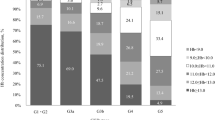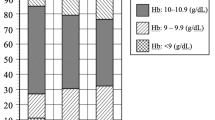Abstract
Background/aims
Anemia is common in patients with chronic kidney disease (CKD). Recently, the erythropoiesis-stimulating agent/hemoglobin level (ESA/Hb) index emerged as a new factor associated with increased morbidity and mortality in this population. In this study, we evaluated the factors that influence the ESA/Hb index in a pre-dialysis CKD population.
Methods
Ninety-five patients were evaluated for clinical and laboratory parameters, nutritional status and ESA/Hb index. For comparison, we divided our population into 3 groups: G I—no ESA treatment, G II—patients with ESA/index below 50th percentile and G III—patients with ESA/Hb index above 50th percentile. We performed single and multiple regression models and logistic regression analysis.
Results
In a multiple regression model, age (t = −3.456, P = 0.001), SGA (t = 2.059, P = 0.047), ferritin (t = 2.386, P = 0.027), Ca × P (t = 2.066, P = 0.043), TNF-α (t = 2.673, P = 0.009) and IL-6 (t = 2.939, P = 0.004) independently influenced the ESA/Hb index. At logistic regression analysis, gender, cardiovascular disease and TNF-α were independently associated with ESA/Hb higher than 50th percentile compared to the other patients (R 2 = 0.457).
Conclusion
In a pre-dialysis population, female gender, cardiovascular disease, malnutrition and inflammation are associated with a higher ESA/Hb index.
Similar content being viewed by others
References
Eschbach JW, Adamson JW (1985) Anemia of end-stage renal disease. Kidney Int 28:1–5
Winearls CG, Oliver DO, Pippard MJ et al (1986) Effect of human erythropoietin derived from recombinant DNA on the anemia of patients maintained by chronic hemodialysis. Lancet 2:1175–1177
Eschbach JW, Egrie JC, Downing MR et al (1987) Correction of the anemia of end-stage renal disease with recombinant human erythropoietin: results of phase I and II clinical trial. N Engl J Med 316:73–78
Wingard RL, Parker RA, Ismail L et al (1995) Efficacy of oral iron therapy in patients receiving recombinant human erythropoietin. Am J Kidney Dis 25:433–439
Silverberg DS, Wexler D, Blum M et al (2003) The cardio-renal anaemia syndrome: does it exist? Nephrol Dial Transplant 18(Suppl 8):viii7–viii12
Collins AJ, Li S, Peter W et al (2001) Death, hospitalization and economic associations among incident haemodialysis patients with hematocrit values of 36 to 39%. J Am Soc Nephrol 12:2465–2473
Foley RN (2002) Anaemia: cardiovascular adaptations and maladaptative responses in chronic kidney disease. Nephrol Dial Transplant 17(Suppl 11):32–34
Astor BC, Coresh J, Heiss G et al (2006) Kidney function and anemia as risk factors for coronary heart disease and mortality: the Atherosclerosis Risk in Communities (ARIC) study. Am Heart J 151:492–500
Leeder SR, Mitchell P, Liew G et al (2006) Low hemoglobin, chronic kidney disease, and risk for coronary heart disease-related death: the Blue Mountains Eye study. J Am Soc Nephrol 17:279–288
Tong EM, Nisseson AR (2001) Erythropoietin and anemia. Semin Nephrol 21:190–203
Revised European best practice guidelines for the management of anaemia in patients with chronic renal failure. Section IV (2004) Failure to respond to treatment. Nephrol Dial Transplant 19(suppl 2):ii32–ii36
Macdougall IC, Cooper AC (2002) Erythropoietin resistance: the role of inflammation and pro-inflammatory cytokines. Nephrol Dial Transplant 17(Suppl 11):39–43
Stenvinkel P (2003) Anaemia and inflammation: what are the implications for the nephrologists? Nephrol Dial Transplant 18(Suppl 8):viii17–viii22
Kalantar-Zadeh K, Ikizler TA, Block G et al (2003) Malnutrition-inflammation complex syndrome in dialysis patients: causes and consequences. Am J Kidney Dis 42:864–881
Neves PL, Morgado E, Faísca M et al (2006) Nutritional and inflammatory status influence darbepoietin dose in pre-dialysis elderly patients. Int Urol Nephrol 38:811–813
Kanbay M, Perazella MA, Kasapoglu B et al (2010) Erythropoiesis stimulatory agent-resistant anemia in dialysis patients: review of causes and management. Blood Purif 29(1):1–12
Cotter DJ, Stefanik K, Zhang Y et al (2004) Hematocrit was not validated as a surrogate end point for survival among epoietin-treated hemodialysis patients. J Clin Epidemiol 57:1086–1095
Zhang Y, Thamer M, Stefanik K et al (2004) Epoietin requirements predict mortality in hemodialysis patients. Am J Kidney Dis 44:866–876
Regidor DL, Kopple JD, Kovesdy CP et al (2006) Associations between changes in hemoglobin and administered erythropoiesis-stimulating agent and survival in hemodialysis patients. J Am Soc Nephrol 17:1181–1191
Lopez-Gomez JM, Porto J, Aljama P (2008) Factors that condition the response to erythropoeitin in patients on hemodialysis and their relation to mortality. Kidney Int 74:S75–S81
Levey AS, Bosch JP, Lewis JB et al (1999) A more accurate method to estimate glomerular filtration rate from serum craetinine: a new prediction equation. Ann Intern Med 130:461–470
Hsu C, McCulloch CE, Curhan GC (2002) Epidemiology of anemia associated with chronic renal insufficiency among adults in the United States: results from the Third National Health and Nutrition Examination Survey. J Am Soc Nephrol 13:504–510
Sarnak MJ, Tighiouart H, Guruprasad M et al (2002) Anemia as a risk factor for cardiovascular disease in the Atherosclerosis Risk in Communities (ARIC) study. J Am Coll Cardiol 40:27–33
Kuriyama S, Tomonari H, Yoshida H et al (1997) Reversal of anemia by erythropoietin therapy retards the progression of chronic renal failure, especially in non diabetic patients. Nephron 77:176–185
Neves PL, Morgado E, Baptista A et al (2007) Anaemia and interleukin-6 are associated with a faster progression to end-stage renal disease. Dial Transplant 36:445–456
Jungers P, Choukroun G, Oualin Z et al (2001) Beneficial influence of recombinant human erythropoietin therapy on the rate of progression of chronic renal failure in predialysis patients. Nephrol Dial Transplant 16:307–312
Lim VS, DeGowin RL, Zavala D et al (1989) Recombinant human erythropoietin treatment in predialysis patients. A double-blind placebo-controlled trial. Ann Intern Med 110:108–114
Revicki DA, Brown RE, Feeny DH et al (1995) Health-related quality of life associated with recombinant human erythropoietin therapy in predialysis chronic renal disease patients. Am J Kidney Dis 25:548–554
Fink J, Blahut S, Reddy M et al (2001) Use of erythropoietin before the initiation of dialysis and its impact on mortality. Am J Kidney Dis 37:348–355
Maddux FW (2007) Effect of erythropoiesis-stimulating agents on healthcare utilization, costs, and outcomes in chronic kidney disease. Ann Pharmacother 41:1761–1769
Drueke TB, Locatelli F, Clyne N et al (2006) Normalization of hemoglobin level in patients with chronic kidney disease and anemia. N Engl J Med 355(20):2071–2084
Singh AK, Szczech L, Tang KL et al (2006) Correction of anemia with epoietin alfa in chronic kidney disease. N Engl J Med 355:2085–2098
Pfeffer MA, Burdmann EA, Chen CY et al (2009) A trial of darbepoietin alfa in type 2 diabetes and chronic kidney disease. N Engl J Med 361:2019–2032
Locatelli F, Andrulli S, Memoli B et al (2006) Nutritional-inflammation status and resistance to erythropoietin therapy in hemodialysis patients. Nephrol Dial Transplant 21:991–998
Barany P, Divino Filho JC, Bergstrom J (1997) High C-reactive protein is a strong predictor of resistance to erythropoeitin in hemodialysis patients. Am J Kidney Dis 29:565–568
Wei M, Bargman JM, Oreopoulus DG (2007) Factors related to erythropoietin hypo-responsiveness in patients on chronic peritoneal dialysis. Int Urol Nephrol 39(3):935–940
Stenvinkel P, Barany P (2002) Anaemia, rHuEPO resistance, and cardiovascular disease in end-stage renal failure: links to inflammation and oxidative stress. Nephrol Dial Transplant 17(suppl 5):32–37
Stenvinkel P, Heimbürger O, Lindholm B et al (2000) Are there two types of malnutrition in chronic renal failure? Evidence for relationships between malnutrition, inflammation and atherosclerosis (MIA syndrome). Nephrol Dial Transplant 15:953–960
Kalantar-Zadeh K, Block G, McAllister CJ et al (2004) Appetite and inflammation, nutrition, anemia, and clinical outcome in hemodialysis patients. Am J Clin Nutr 80:297–307
McKevitt PM, Jones JF, Lane DA et al (1990) The elderly on dialysis. Some considerations in compliance. Am J Kidney Dis 16:346–350
Bonanno G, Urso S, Lo Faro F et al (1996) Parathyroid hormone in a population of elderly patients on hemodialysis (preliminary data). Arch Gerontol Geriatr 22:441–445
Di lorio B, Stellato D, De Santo N et al (2004) Association of gender and age with erythropoietin resistance in hemodialysis patients: role of menstrual status. Blood Purif 22:423–427
Ifudu O, Uribarri J, Rajwani I et al (2001) Gender modulates responsiveness to recombinant erythropoietin. Am J Kidney Dis 38:518–522
Bamgbola OF, Kaskel FJ, Coco M (2009) Analyses of age, gender and other risk factors of EPO resistance in pediatric and adult dialysis cohorts. Pediatr Nephrol 24:571–579
Author information
Authors and Affiliations
Corresponding author
Rights and permissions
About this article
Cite this article
de Lurdes Agostinho Cabrita, A., Pinho, A., Malho, A. et al. Risk factors for high erythropoiesis stimulating agent resistance index in pre-dialysis chronic kidney disease patients, stages 4 and 5. Int Urol Nephrol 43, 835–840 (2011). https://doi.org/10.1007/s11255-010-9805-9
Received:
Accepted:
Published:
Issue Date:
DOI: https://doi.org/10.1007/s11255-010-9805-9




